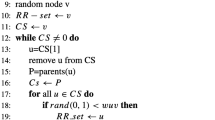Abstract
Community detection has drawn significant attention as new media generates big data every day. To provide statistical testing procedures for community detection in social networks, a scanning method has been developed based on the likelihood of Poisson random graph. However, the scan statistics did not consider detecting communities of the attributes with power-law distribution. Power-law distribution, generally followed by network attributes, is conspicuous in many scientific situations. This paper aims at extending the scanning method to analyze a social network in which attributes follow power-law distribution. Besides the theoretical construction, simulation studies are performed to verify the feasibility of the proposed method, and an authorship network is used to demonstrate the proposed method.





Similar content being viewed by others
References
Balasubramanyan R, Cohen WW (2011) Block-lda: Jointly modeling entity-annotated text and entity-entity links. SDM, SIAM 11:450–461
Beebe NH (2002) Nelson hf beebe bibliographies page. http://www.math.utah.edu/~beebe/bibliographies.html
Blei DM, Ng AY, Jordan MI (2003) Latent Dirichlet allocation. J Mach Learn Res 3:993–1022
Burroughs SM, Tebbens SF (2001) Upper-truncated power laws in natural systems. Pure Appl Geophys 158(4):741–757
Clauset A, Shalizi CR, Newman ME (2009) Power-law distributions in empirical data. SIAM Rev 51(4):661–703
Erdős P, Rényi A (1959) On random graphs. Publ Math Debr 6:290–297
Fortunato S (2010) Community detection in graphs. Phys Rep 486(3):75–174
Fortunato S, Barthélemy M (2007) Resolution limit in community detection. In: Proceedings of the National Academy of Sciences 104:36–41
Gillespie CS (2013) Fitting heavy tailed distributions: the poweRlaw package. R package version (20):2
Goldstein ML, Morris SA, Yen GG (2004) Problems with fitting to the power-law distribution. Eur Phys J B Condens Syst 41(2):255–258
Guimera R, Sales-Pardo M, Amaral LAN (2004) Modularity from fluctuations in random graphs and complex networks. Phys Rev E 70(2):025–101
Handcock MS, Raftery AE, Tantrum JM (2007) Model-based clustering for social networks. J Roy Stat Soc A Stat 170(2):301–354
Heard NA, Weston DJ, Platanioti K, Hand DJ (2010) Bayesian anomaly detection methods for social networks. Ann Appl Stat 4(2):645–662
Kossinets G, Watts DJ (2006) Empirical analysis of an evolving social network. Science 311(5757):88–90
Kulldorff M (1997) A spatial scan statistic. Commun Stat Theor M 26(6):1481–1496
Kulldorff M, Huang L, Pickle L, Duczmal L (2006) An elliptic spatial scan statistic. Stat Med 25(22):3929–3943
Liu Y, Niculescu-Mizil A, Gryc W (2009) Topic-link lda: joint models of topic and author community. In: Proceedings of the 26th Annual International Conference on Machine Learning, pp 665–672
Louch H (2000) Personal network integration: transitivity and homophily in strong-tie relations. Soc Netw 22(1):45–64
McPherson M, Smith-Lovin L, Cook JM (2001) Birds of a feather: Homophily in social networks. Annu Rev Sociol pp 415–444
Naus JI (1966) Some probabilities, expectations and variances for the size of largest clusters and smallest intervals. J Am Stat Assoc 61(316):1191–1199
Newman ME (2004) Fast algorithm for detecting community structure in networks. Phys Rev E 69(6):066–133
Newman ME, Girvan M (2004) Finding and evaluating community structure in networks. Phys Rev E 69(2):026–113
Tango T, Takahashi K (2005) A flexibly shaped spatial scan statistic for detecting clusters. Int J Health Geogr 4(1):11
Wang B, Phillips JM, Schreiber R, Wilkinson DM, Mishra N, Tarjan R (2008) Spatial scan statistics for graph clustering. In: SDM, pp 727–738
Yang J, McAuley J, Leskovec J (2013) Community detection in networks with node attributes. In: Data Mining (ICDM), 2013 IEEE 13th International Conference on, pp 1151–1156
Zhou Y, Cheng H, Yu JX (2009) Graph clustering based on structural/attribute similarities. In: Proceedings of the VLDB Endowment 2:718–729
Acknowledgments
This work was supported by (a) Career Development Award of Academia Sinica (Taiwan) grant number 103-CDA-M04 and National Science Council (Taiwan) grant number 102-2628-M-001-002-MY3, for Phoa, (b) Thematic Research Program of Academia Sinica (Taiwan) grant number AS-103-TP-C03 for Phoa and Wang.
Author information
Authors and Affiliations
Corresponding author
Rights and permissions
About this article
Cite this article
Wang, TC., Phoa, F.K.H. & Hsu, TC. Power-law distributions of attributes in community detection. Soc. Netw. Anal. Min. 5, 45 (2015). https://doi.org/10.1007/s13278-015-0283-z
Received:
Revised:
Accepted:
Published:
DOI: https://doi.org/10.1007/s13278-015-0283-z




